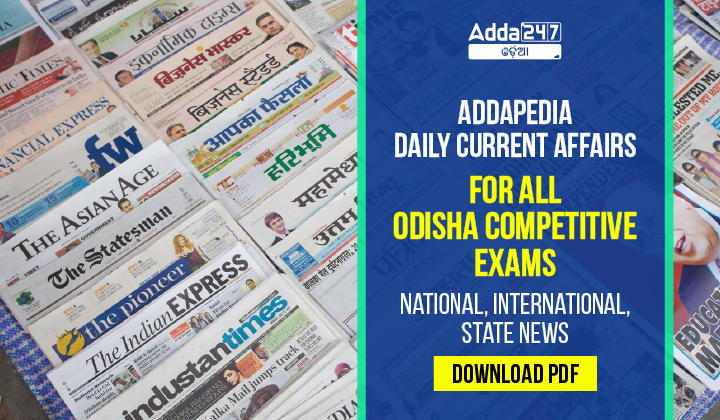As you are aware, in all competitive exams, the “Daily Current Affairs Section” holds significant importance in determining the cutoff scores. Therefore, if you excel in this section, you will have a better chance of achieving higher marks in these exams and securing a spot on the merit list.
Addapedia Odisha – Daily Current Affairs – 12 April 2024
| National and International News |
| CDP-SURAKSHA |
Context;
- The government has introduced a new digital platform called CDP-SURAKSHA to disburse subsidies to horticulture farmers as part of the Cluster Development Programme (CDP), an initiative to promote horticulture crops and boost the sector’s growth.
- The CDP-SURAKSHA is essentially a digital platform.
- SURAKSHA stands for “System for Unified Resource Allocation, Knowledge, and Secure Horticulture Assistance.”
Key points:
- CDP-SURAKSHA enables instant subsidy disbursal to farmers’ bank accounts using e-RUPI vouchers, facilitating transactions through the National Payments Corporation of India (NPCI).
- CDP-SURAKSHA’s features include database integration with PM-KISAN, cloud-based server space from NIC, UIDAI validation, eRUPI integration, LGD, content management system, geotagging, and geo-fencing.
- e-RUPI is a one-time payment mechanism from NPCI that doesn’t require a card, digital payment app, or internet banking access.
- It can be shared with beneficiaries via SMS or QR code.
- The CDP aims to develop horticulture clusters, with 55 identified clusters and 12 selected for the pilot.
- The initiative will cover about 9 lakh hectares and benefit 10 lakh farmers, attracting private investment of Rs 8,250 crore.
|
| Israel Deploys C-Dome Defense System |
Context:
- Israel recently deployed the C-Dome defense system for the first time to intercept a suspicious aerial target near the southern city of Eilat.
Key points:
- This action came after an alert in the area, which had previously been targeted by missile fire from Yemen’s Houthi rebels.
- The C-Dome, a naval adaptation of the Iron Dome, successfully intercepted the target, marking its maiden operational use.
C-Dome: Naval Adaptation of Iron Dome
- The C-Dome defense system, mounted on Sa’ar 6-class corvettes, is the naval counterpart of the land-based Iron Dome.
- Developed by Rafael Advanced Defence Systems, the C-Dome employs the same interceptor technology as the Iron Dome, providing robust defense against rocket and missile threats.
- This operational debut underscores Israel’s ongoing efforts to enhance its defensive capabilities in response to evolving security challenges.
|
| Total solar eclipse
|
Context:
- During the Total Solar Eclipse on April 8, 2024, North America, Mexico, and Canada experienced a momentary plunge into darkness.
- The crew members of the International Space Station had a unique perspective, capturing the Moon’s shadow cast over Earth.
Solar eclipse and its different types:
- A solar eclipse occurs when the Moon moves between Earth and the Sun, blocking sunlight either fully or partially.
- There are four types of solar eclipses: total, annular, partial, and hybrid.
- In a total solar eclipse, the Moon completely blocks the Sun, darkening the sky, and observers may see the Sun’s corona.
- An annular solar eclipse happens when the Moon covers the Sun’s center, leaving a ring of fire visible.
- A partial solar eclipse occurs when the Moon partially covers the Sun, creating a crescent shape.
- Both partial and annular eclipses have regions outside the Moon’s shadow seeing a partial eclipse.
- The partial solar eclipse is the most common type.
- The hybrid solar eclipse is rare, shifting between total and annular as the Moon’s shadow moves.
How often does a solar eclipse take place?
- Solar eclipses occur during the new moon phase when the Moon and Sun align on the same side of Earth.
- A new moon happens approximately every 29.5 days due to the Moon’s orbit around Earth.
- Solar eclipses don’t occur every month but rather between two to five times annually.
- The Moon’s orbit is tilted about five degrees relative to Earth’s orbit around the Sun, causing the Moon’s shadow to often miss Earth, resulting in fewer opportunities for solar eclipses.
- Nodes are points where the Moon’s orbit intersects with Earth’s orbit, creating opportunities for solar eclipses when the new moon crosses these nodes.
Why is a total solar eclipse so rare?
-
- Total solar eclipses occur about once every 18 months.
- A specific location on Earth experiences a total solar eclipse only once every 400 years.
- Total eclipses are rare because they require being within the umbra, the darkest part of the shadow, which covers less than one percent of the Earth’s surface during an eclipse.
- Due to the large portion of Earth being water and uninhabited land, it’s rare for many people to witness a total solar eclipse at once.
|
| Kala Azar |
Context:
- India has successfully eliminated visceral leishmaniasis, commonly known as kala-azar, meeting the target set by the National Centre for Vector Borne Diseases Control (NCVBDC).
- Initially aiming for elimination by 2010, India extended the target until 2023 due to persistent challenges.
- Kala-azar, a vector-borne disease transmitted through sandfly bites, has been a significant health challenge in states like Bihar, Jharkhand, West Bengal, and Uttar Pradesh.
Key points:
-
- According to the NCVBDC, India reported only 520 cases of kala-azar in 2023, meeting the World Health Organization’s (WHO) elimination criteria, which defines elimination as no block in the country reporting more than one case per 10,000 people.
- In 2020, India accounted for 18% of the global burden of kala-azar.
About:
- Visceral leishmaniasis, commonly known as kala-azar (KA), derives its name from the late nineteenth century in India.
- The term “kala-azar” translates to “black disease,” describing the greyish or blackish discoloration of the skin that occurs during infection.
- This name comes from the Hindi word for black (kala) and the Persian word for disease (azar).
- Kala-azar is a slowly progressing indigenous disease caused by a protozoan parasite belonging to the genus Leishmania.
- In India, Leishmania donovani is the sole parasite responsible for causing this disease.
- The parasite primarily infects the reticuloendothelial system and is commonly found in high numbers in the bone marrow, spleen, and liver.
|
| Suvidha Portal
|
Context:
- The Suvidha Portal has received over 73,000 applications since the announcement of General Elections 2024.
About:
- It is an online platform accessible at https://suvidha.eci.gov.in, designed for political parties and candidates to submit permission requests remotely.
- The portal also offers offline submission options for inclusivity.
- Managed by nodal officers across state departments, the IT platform of Suvidha Portal aims to facilitate the efficient processing of permission requests.
- Additionally, it has a companion app available on IoS and Android platforms, enabling real-time tracking of request status.
- One of the key features of the Suvidha Portal is its transparency.
- It provides real-time tracking of applications, status updates, timestamped submissions, and communication via SMS.
- This transparency supports the scrutiny of election expenditures for greater accountability.
- The Election Commission’s commitment is to facilitate a fair, efficient, and transparent electoral environment.
- The Suvidha Portal ensures equal access to permissions and clearances for all parties and candidates, aligning with this commitment.
|
| Odisha Regional Specific News |
| Sustainability grants extended to research centres of varieties in Odisha |
Context:
- Sustainability grants have been awarded to 11 research centers of excellence (CoEs) across five public universities in Odisha.
Key points:
- These CoEs were established as part of the World Bank-supported Odisha Higher Education Programme for Excellence and Equity (OHEPEE) and phase two of the Rashtriya Uchchatar Shiksha Abhiyan (RUSA).
- The Odisha State Higher Education Council, along with a panel of experts, recently assessed the research work of these CoEs and awarded them a sustainability grant totaling approximately Rs 61.5 lakh for the academic sessions of 2023-24 and 2024-25 under the Mukhyamantri Research and Innovation Fellowship programme.
- Among these CoEs, Sambalpur University’s research on ‘natural products and therapeutics’ received the highest grant of Rs 35 lakh.
- Despite these challenges, the state government continues to support the CoEs by providing research grants to fellows and sustainability grants for maintenance of equipment, research internships, publication of critical texts, and engagement of research associates.
|
| Sarhul festival |
Context:
- The Sarhul festival, a significant religious event for tribal communities, was celebrated in Sundargarh district.
About:
- The spring festival known as Sarhul holds great cultural significance for indigenous tribes like the Mundas, Oraons, and Santhals.
- Among these, the Oraon community especially celebrates Sarhul as the largest spring festival, typically observed in March and April.
- In their native language, it is called “Khaddi,” symbolizing the symbolic union or marriage of the earth.
- The forest flower sakhua or Sal is central to this festival, representing deep cultural ties within the forest ecosystem.
|
| World Parkinson’s Day |
Context:
- World Parkinson’s Day is observed every year on April 11th.
This day serves two key purposes:
- Raising Awareness:
- Parkinson’s disease is a chronic neurodegenerative disorder impacting millions globally.
- World Parkinson’s Day brings attention to this condition, its symptoms, and the challenges faced by patients and their families.
- Honoring Dr. James Parkinson:
- The day also coincides with the birthday of Dr. James Parkinson, who first described the condition in 1817.
About:
-
- In 1997, the European Association for Parkinson’s Disease (now known as Parkinson’s Europe) announced that April 11 will be observed as World Parkinson’s Day every year.
- The World Health Organization (WHO) also co-sponsored the initiative.
Theme:
- The theme for World Parkinson’s Day 2024 is “Finding Your Light.”
- This theme emphasizes the importance of hope, resilience, and maintaining a positive outlook for people living with Parkinson’s disease.
|
| International Day of Human Space Flight |
Context:
- The International Day of Human Space Flight is celebrated annually on 12 April.
- It marks the anniversary of the first human space flight by Yuri Gagarin in 1961.
About:
- It was proclaimed at the 65th session of the United Nations General Assembly on 7 April 2011.
Key Points:
- This day celebrates the dawn of the space age and the incredible achievements in space exploration.
- It also highlights the importance of space science and technology for our well-being and sustainable development.
Theme:
- The theme for International Day of Human Space Flight is “Encourage scientific curiosity”.
- It urges individuals and communities to embrace curiosity as a driving force for discovery and innovation.
Did you Know?
- Yuri Gagarin was the first human to travel to space.
|
| International Children’s University Day |
Context:
-
- The International Children’s University Day is a brand new celebration launched in 2024
- It will be celebrated on April 11 every year.
- It’s a day to recognize the important role of children’s universities and similar programs around the world.
About:
- At the last eucu.net meeting in Vienna in November 2023, 11. April was declared the International Day of Children’s Universities.
Goal:
- Raise awareness about children’s universities and their mission of providing high-quality science, technology, engineering, arts, mathematics (STEAMH) activities.
- Highlight the importance of making research and science accessible to all children.
- Showcase the work of children’s universities and encourage more participation in these programs.
|
| National Safe Motherhood Day |
Context:
- National Safe Motherhood Day is observed annually on April 11th in India
- It raises awareness about the critical issue of maternal health.
- It highlights the risks millions of women face during pregnancy and childbirth.
Key Points:
- Established in 2003 by the White Ribbon Alliance India (WRAI).
- Aims to improve access to quality maternal healthcare services.
- Promotes healthy pregnancy practices and reduces maternal mortality rates.
- This day also serves as a reminder of the importance of ensuring every mother has a safe and healthy experience throughout motherhood.
Theme:
- The theme of 2024 is “Remain at home amid coronavirus, protect mother and infant”
|
| Copyright © by Adda247
All rights are reserved. No part of this document may be reproduced, stored in a retrieval system or transmitted in any form or by any means, electronic, mechanical, photocopying, recording or otherwise, without prior permission of Adda247. |














